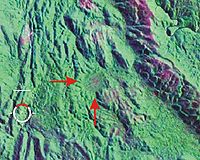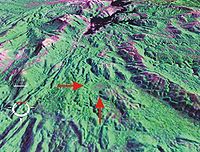
Darwin Crater
Encyclopedia


Meteorite
A meteorite is a natural object originating in outer space that survives impact with the Earth's surface. Meteorites can be big or small. Most meteorites derive from small astronomical objects called meteoroids, but they are also sometimes produced by impacts of asteroids...
impact crater
Impact crater
In the broadest sense, the term impact crater can be applied to any depression, natural or manmade, resulting from the high velocity impact of a projectile with a larger body...
in Western Tasmania, Australia
Australia
Australia , officially the Commonwealth of Australia, is a country in the Southern Hemisphere comprising the mainland of the Australian continent, the island of Tasmania, and numerous smaller islands in the Indian and Pacific Oceans. It is the world's sixth-largest country by total area...
. It is expressed as a rimless circular flat-floored depression, 1.2 kilometre (0.745647283979768 mi) in diameter, within mountainous and heavily forested terrain 26 kilometres (16.2 mi) south of Queenstown
Queenstown, Tasmania
Queenstown is a town in the West Coast region of the island of Tasmania. It is located in a valley on western slopes of Mount Owen on the West Coast Range.It had a population of 5,119 people . At the 2006 census, Queenstown had a population of 2,117....
. It lies east of the West Coast Range and just within the Franklin-Gordon Wild Rivers National Park
Franklin-Gordon Wild Rivers National Park
Franklin-Gordon Wild Rivers is a national park in Tasmania, Australia, 117 km west of Hobart. It is named after the two main river systems lying within the bounds of the park - the Franklin River and the Gordon River.- Location :...
.
The crater was discovered by the geologist
Geologist
A geologist is a scientist who studies the solid and liquid matter that constitutes the Earth as well as the processes and history that has shaped it. Geologists usually engage in studying geology. Geologists, studying more of an applied science than a theoretical one, must approach Geology using...
R. J. Ford in 1972, after a search for the source of Darwin glass
Darwin Glass
Darwin glass is a natural glass found south of Queenstown in West Coast, Tasmania. It takes its name from Mount Darwin in the West Coast Range, where it was first reported, and later gave its name to Darwin Crater, a probable impact crater, and the inferred source of the glass.-Occurrence:Fragments...
, an impact glass
Impactite
Impactite is an informal term describing a rock created or modified by the impact of a meteorite. The term encompasses shock-metamorphosed target rocks, melts and mixtures of the two, as well as sedimentary rocks with significant impact-derived components .-Some localities:*Nördlinger Ries...
found over more than 400 square kilometres (154.4 sq mi) of southwestern Tasmania. Geophysical
Exploration geophysics
Exploration geophysics is the applied branch of geophysics which uses surface methods to measure the physical properties of the subsurface Earth, in order to detect or infer the presence and position of ore minerals, hydrocarbons, geothermal reservoirs, groundwater reservoirs, and other geological...
investigations and drilling
Exploration diamond drilling
Exploration diamond drilling is used in the mining industry to probe the contents of known ore deposits and potential sites. By withdrawing a small diameter core of rock from the orebody, geologists can analyze the core by chemical assay and conduct petrologic, structural and mineralogic studies...
have shown that the crater is filled with up to 230 metres (754.6 ft) of breccia
Breccia
Breccia is a rock composed of broken fragments of minerals or rock cemented together by a fine-grained matrix, that can be either similar to or different from the composition of the fragments....
capped by Pleistocene
Pleistocene
The Pleistocene is the epoch from 2,588,000 to 11,700 years BP that spans the world's recent period of repeated glaciations. The name pleistocene is derived from the Greek and ....
lake sediment
Sediment
Sediment is naturally occurring material that is broken down by processes of weathering and erosion, and is subsequently transported by the action of fluids such as wind, water, or ice, and/or by the force of gravity acting on the particle itself....
s. Although definitive proof of an impact origin of the crater is lacking, the impact hypothesis is strongly supported by the relationship of the glass to the crater, as well as the stratigraphy
Stratigraphy
Stratigraphy, a branch of geology, studies rock layers and layering . It is primarily used in the study of sedimentary and layered volcanic rocks....
and deformation of the crater-filling material.
If the crater is indeed the source of the glass, the age of Darwin Crater is 816,000 ± 7,000 years—the age of Darwin glass as determined by argon dating
Argon-argon dating
Argon-argon dating is a radiometric dating method invented to supersede potassium-argon dating in accuracy. The older method required two samples for dating while the newer method requires only one...
methods.

